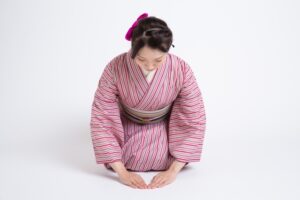You probably know that cultures and manners differ from country to country.
There are many things that may be acceptable in your own country but are considered inappropriate in Japan.
This guide will introduce some key Japanese rules and etiquette to help you navigate social situations smoothly.
Manners in Public Spaces
- Keep Noise Down: Loud conversations and talking on cell phones on trains and buses are generally considered poor manners.
- Smoking Areas: Smoking is only permitted in designated smoking areas.
- Take Trash With You: There are not many trash cans on the streets, so the general rule is to take your trash home or dispose of it in designated bins (like at convenience stores).
- Don’t Cut in Line: Always go to the end of the line at stores, train platforms, or anywhere people are queuing.
- Check Photography Rules: Some temples, shrines, and museums prohibit photography, so be sure to check for signs.
Dining Etiquette
- Chopsticks in Food: Sticking your chopsticks upright into your food is a gesture associated with funerals and is a major taboo.
- Passing Food with Chopsticks: Passing food from your chopsticks to another person’s chopsticks is also a funeral-related taboo.
- Pointing with Chopsticks: Pointing at people or food with your chopsticks is considered rude.
- Slurping Noodles: Slurping noodles (ramen, udon, soba) is acceptable, but making chewing noises with other foods is considered impolite.
- Holding Bowls: When eating, it is customary to hold your rice bowl or other small bowls in your hand.
Other Cultural Manners
- Take Off Your Shoes: Be sure to take off your shoes when entering someone’s home, a tatami room, or certain temples and restaurants.
- No Tipping: Tipping is not a custom in Japan and can sometimes cause confusion.
- Personal Space: Japanese culture places a high value on personal space, so avoid excessive physical contact.
- Blowing Your Nose: Blowing your nose loudly in public is considered impolite. It’s better to do so discreetly or in a restroom.
- Escalator Etiquette: People stand on one side to let others pass. This side varies by region (left in Tokyo, right in Osaka).
There are many detailed points of etiquette, but just remembering these will make a great impression.
Experience Japanese Etiquette Firsthand
The best way to understand Japanese manners is to experience them.
A Japanese Tea Ceremony is a perfect opportunity to learn about respect, grace, and hospitality in a traditional setting.
Under the guidance of a master, you can practice these customs and deepen your appreciation for the culture.
You Might Also Like
Knowing basic greetings is just as important as knowing the etiquette.
Learn a few magic phrases to connect with locals.








